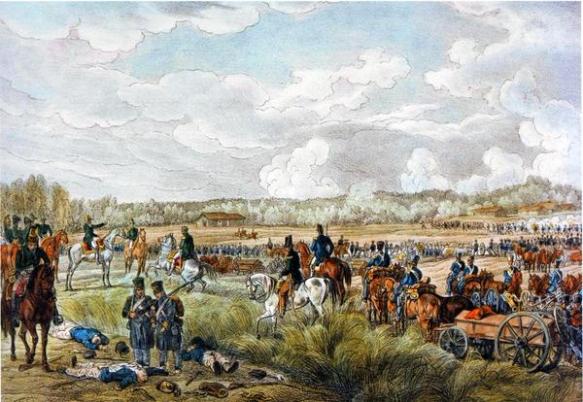A rearguard action fought during the campaign of 1812 between Russian and French forces near the village of Ostrovno, 12 miles west of Vitebsk. As Napoleon’s Grande Armée invaded Russia in June, the 1st Western Army under General Mikhail Barclay de Tolly quickly retreated to the east. On 23 July it approached Vitebsk, where Barclay de Tolly planned to wait for the 2nd Western Army under General Prince Peter Bagration, who was marching to join him via Mogilev. Receiving intelligence on the French advance, Barclay de Tolly decided to delay the enemy until the arrival of Bagration. On 24 July he designated General Alexander Osterman-Tolstoy’s 4th Corps as a rear guard and reinforced it with the Ingermanland and Nezhinsk Dragoon, Life Guard Dragoon, Sumsk Hussar, and Life Guard Hussar Regiments, and a company of horse artillery.
The French advanced along both banks of the Western Dvina River and encountered Osterman-Tolstoy’s troops near Ostrovno, where Russian cavalry initially overwhelmed the advance elements of General Etienne, comte de Nansouty’s 1st Cavalry Corps. On 25 July Marshal Joachim Murat arrived with his advance guard (1st Light Cavalry Division) under General Jean Pierre Bruyeres; the 1st Heavy Cavalry Division under General Antoine Louis Decrest de Saint Germain; and two battalions of the 8th Légere from the 13th Division, under General Alexis Joseph Delzons. On the morning of the twenty-fifth, as the French approached Ostrovno, the 2nd Brigade of the 1st Light Cavalry Division routed two squadrons of the Life Guard Hussars and captured six horse artillery guns. Both sides threw in reinforcements, and the battle began.
General Saint Germain’s cavalry division was deployed on the French left flank, the 8th Légere and sixteen squadrons of Bruyeres’s cavalry division were in the center, and the remaining squadrons of Bruyeres’s division were on the right flank. Delzons’s division was still en route. Russian troops were deployed on both sides of the main road to Vitebsk, protected by dense forest and swamps on the flanks. Osterman-Tolstoy moved the Ingermanland Dragoon Regiment to observe the French right flank. He then deployed the 11th Division under General Nikolay Bakhmetyev and the remaining artillery in the first line, with the 23rd Division under General Aleksey Bakhmetyev in the second line, supported by the Sumsk Hussars.
The initial artillery bombardment was followed by a charge of the Ingermanland Dragoon Regiment against the French right flank. However, the Russian attack proved disastrous as the French cavalry counterattacked and routed the Ingermanland Dragoons, capturing some 200 of them. In the center, Russian troops suffered considerable casualties from the fire of French tirailleurs (light infantry skirmishers), and Osterman-Tolstoy ordered a bayonet attack to drive them back. Yet, as the Russians advanced, the French cavalry charged their exposed flank and inflicted heavy casualties.
Notwithstanding these successes, the French could not make any real headway because the Russians took up positions in a wood. Murat then brought his artillery closer and opened canister fire against the opposing infantry, which though suffering heavy casualties continued to hold their ground. When he was told about the losses and asked for instructions, Osterman-Tolstoy famously responded, “Just hold ground and die.” The Russians managed to rally their troops, while Osterman-Tolstoy led infantry attacks against both French flanks, which were repulsed. Delzons’s division, meanwhile, arrived on the battlefield and threatened the Russian right flank. Osterman-Tolstoy had no alternative but to withdraw to more favorable positions, and the fighting soon ended because of darkness.
During the night, Barclay de Tolly reinforced Osterman-Tolstoy with the 1st Reserve Cavalry Corps under General Fedor Uvarov and the 3rd Division under General Peter Konovnitsyn. The French also received reinforcements, drawn from the main forces of the Grand Armée, which gradually reached the scene of the fighting. At dawn on 26 July Osterman-Tolstoy began an orderly retreat toward the village of Kakuvyachino, 3 miles east of Ostrovno. The battle resumed that morning, with the Russians holding back the French advance. Despite initial French success (capturing three guns) when Murat personally led cavalry charges, the Russians repulsed all enemy attacks. The fighting continued until late evening, when the Russians finally retreated to Vitebsk. The Russians suffered heavy casualties, losing more than 3,700 men, including 834 killed and 1,855 wounded, and the remainder captured or missing.
References and further reading Fabry, Gabriel. 1902. Campagne de Russie. Paris: Gougy. Kharkevich, V. 1901. Voina 1812 goda. Ot Nemana do Smolenska. Vilna: Izd. Nikolaevskoi akademii general’nago shtaba. Rossetti, General. 1998. Journal d’un compagnon de Murat. Paris: Librairie Historique F. Teissedre.
